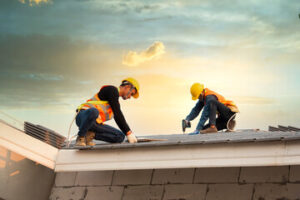If a roof is nearing the end of its expected lifespan or suffering from severe storm damage, a replacement may be necessary. Severe storm damage, such as widespread missing shingles and sagging decking, typically means that the structure is compromised and will need to be replaced.

Replacing damaged shingles quickly is essential to prevent future leaks and other structural problems. Contact Five Star Roofing and Contracting for professional help.
The roof’s material and complexity play a major role in determining repair costs. The size and pitch of the roof also influences labor costs. Additionally, local factors can impact prices, including market demand and weather conditions. The amount of damage is another key factor in estimating repair costs. Small issues, like a few loose shingles or a leaky gutter, may cost as little as $150 to $300. Moderate repairs, such as replacing flashing or repairing leaks, can cost up to $500. Major repairs after severe storms or extensive damage can cost up to $1,000 and higher.
Depending on the extent of the damage, it may be more cost-efficient to invest in a full replacement. Some common indicators that it’s time to replace include widespread leaks, structural damage or rotted wood. Regular inspections can help homeowners recognize these warning signs before they become costly damages.
Another factor that impacts costs is the age of the roof. An old, deteriorating roof will require more frequent and expensive repairs. It may be more cost-efficient to replace an older roof with resilient materials than to continue repairing existing damage.
If you’re planning to sell your home in the near future, a new roof can improve curb appeal and increase its value. New roofing materials also add to energy efficiency and may help lower your home insurance premiums.
To ensure a high-quality result, you should always choose a professional roofer to perform your repair work. They’ll follow a detailed process for inspecting, preparing and installing the new roofing materials. Moreover, a professional will handle the removal and disposal of the old materials as well.
The final cost of a roof repair project includes local sales tax, materials and supplies. Additional costs can include permit fees, inspections and debris disposal. The total cost of the project also depends on whether you need a general contractor to organize and supervise the repair. Additionally, you may need to pay extra for a warranty or guarantee. A warranty covers both the materials and the installation, which can reduce your risk of expensive repairs.
Accessibility
The availability and accessibility of repair materials can have a significant impact on the cost-effectiveness of emergency repairs. Localized materials that can be readily sourced reduce transportation costs and ensure timely installation, which minimizes overall expense. Also, materials that are easy to work with or require minimal specialized skill can decrease labor expenses.
Another critical factor in evaluating roof repair options is the extent of damage. Minor issues such as replacing a few shingles or patching a leak are generally less costly than addressing significant structural damage, which can significantly increase the overall cost of the project.
A reputable contractor will offer competitive pricing while maintaining high standards of workmanship and customer service. They will provide warranty and guarantee coverage that can provide peace of mind. In addition, a reliable contractor will be able to select durable materials that balance costs and performance, such as roofing membranes and advanced polymer solutions.
Prioritizing safety is a must for conducting any type of roof repair, especially in an emergency situation. Always ensure that you have the proper safety equipment, including a sturdy ladder framework and adequate safety ropes for steep roofs. Additionally, it is important to wear appropriate footwear with good traction and to stay clear of power lines.
Lastly, homeowners should consider eco-friendly repair materials that promote sustainability and environmental stewardship. These options may be more expensive than traditional materials, but they can save money in the long run by reducing energy costs and maintenance costs. For example, using reclaimed rubber for roof repair is an excellent alternative to conventional materials because it offers superior waterproofing and insulation properties. Moreover, it is safe for the environment and can be used for long-term applications.
Materials
Whether you’re repairing a small leak or replacing damaged shingles, the materials you use play an important role in roof longevity. Different roofing materials have unique properties, and they require specific patching techniques. Choosing the right materials will ensure that your repair job is both safe and effective.
Roofing repair projects are often dangerous, even for professionals. The most common error is ignoring weather conditions and working on the roof in wet or windy conditions. This can compromise safety and damage the quality of the repair work.
To minimize the risk of injury, workers should always wear protective equipment. The equipment should include slip-resistant shoes, a safety harness and lanyard, and a pair of gloves. In addition, it’s important to keep the area clean of debris and tripping hazards. It’s also a good idea to wear a helmet to protect against falling debris.
Other safety measures to consider include regularly conducting roof inspections and identifying problems promptly. You should also trim overhanging branches to prevent them from rubbing against the roof or causing damage during storms. Lastly, you should reapply sealants as needed to maintain optimal protection.
If you’re planning on repairing the roof yourself, it’s a good idea to read the manufacturer’s warranty before you begin work. Many warranties require that the work be performed by a professional to avoid voiding the coverage. In some cases, a do-it-yourself project can void the warranty, which means you’ll be responsible for all future costs.
It’s also a good idea to purchase a ladder that fits your height and weight. If possible, choose a wood ladder over a metal one to avoid the risk of electrocution. Also, make sure you don’t work on a live power line, as this can cause serious injuries and property damage.
Before starting any roof repairs, you should take a photo of the damage for insurance purposes. This will help you file an insurance claim if necessary. Moreover, you should also inspect the roof for signs of water damage and other structural issues. Also, you should clean the gutters and re-seal any open joints to prevent further damage.
Safety
In addition to identifying roof damage and understanding repair costs, homeowners should be aware of the safety measures needed for this type of work. Working on a roof involves elevated locations that can make falls a significant hazard, as well as a variety of other hazards that can lead to severe injuries or even death. Fall protection systems and appropriate safety training can minimize these risks, and a plan for waste disposal can help maintain a safe work environment.
While the most obvious signs of roof damage are shingle loss or leaks, other less visible damages should be considered as well. These include water spots on the ceiling and damp areas in the attic, which indicate that the attic needs insulation to reduce moisture. If you see these signs, consider scheduling roof repairs as soon as possible to prevent further damage.
A roof that is damaged can also lower the value of a home, making it more difficult to sell when the time comes to move. This is because potential buyers may view the home as being in disrepair, requiring them to negotiate the asking price down to attract interest.
Some roofing materials, including asbestos and lead-based paints, pose health risks when disturbed or removed during a repair project. These materials should only be handled by trained professionals who have the proper PPE. It’s important to conduct a material assessment before beginning any roof repairs, and always follow proper handling and disposal guidelines.
Ladders are another hazard to consider when performing roof repairs, and they should be inspected and used according to the manufacturer’s instructions. Avoid carrying anything up a ladder in your hands, and be sure to use a harness and lanyard when climbing. Also, be sure to keep three points of contact with the ladder while working and center your weight on each rung.
Lastly, be aware that wind damage can cause problems with the flashing around vents, chimneys and skylights, so it’s essential to check these regularly. Replacing damaged flashing can prevent leaks, water damage and ice dams. It’s also a good idea to have any rusted gutters replaced before winter arrives.



